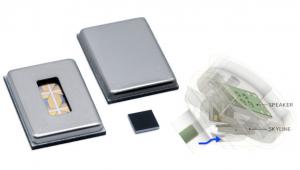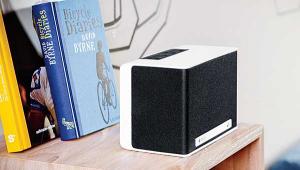Tom Vodhanel, President, Power Sound Audio
 Tom Vodhanel is president and founder of Power Sound Audio, an Ohio-based company that specializes in subwoofers and sells direct through its website. Tom is also known as the “V” in SVS, another company that started out as a subwoofer specialist, and which he co-founded. Excerpts from this interview appear in the feature story “Subwoofers: The Guts and the Glory.”
Tom Vodhanel is president and founder of Power Sound Audio, an Ohio-based company that specializes in subwoofers and sells direct through its website. Tom is also known as the “V” in SVS, another company that started out as a subwoofer specialist, and which he co-founded. Excerpts from this interview appear in the feature story “Subwoofers: The Guts and the Glory.”
S&V: What’s the most important in a subwoofer: the driver, the enclosure or the amplifier?
TV: You hit the big three. You can optimize any of the two, but if the third one is off you’ve got a problem. They maximize the capabilities of each other. Now with DSP [digital signal processing] available in so many of the amplifiers, you get more wiggle room. You can adapt an amp to a smaller enclosure and have it still work really well, and DSP allows you to do that adaptation better and much quicker than you could with analog. But if you miss any of those three, a really good design can turn into an average design.
S&V: Do you have a preference for ported, sealed, or passive radiator subwoofers? How do the design decisions differ among those three?
TV: That decision depends on a lot of things. If you’re deciding on ported versus passive—which in a lot of ways is sort of the same thing—it depends on how small of an enclosure you want. If you want your frequency response to go down to 20 Hz or into the teens, and you want a small sub, you can’t do it with a port because the port would need to be larger than the subwoofer. So in that case you go with a passive radiator. With a sealed box it’s very straightforward. You have the driver, the enclosure and you can DSP it for very precise frequency response goals.
S&V: How would you recommend an audio enthusiast decide among the three different alignments?
TV: In a smaller room, anything under 3,000 cubic feet effective room volume, including the room space it’s open to, I usually prefer a sealed enclosure. That’s with our subs. We have fairly large enclosures, a lot of cone area, and use shallow roll offs in the deep bass. This often gives response down to the 7 to 10 Hz range with our sealed models.
S&V: You’re able to get enough output at low frequencies even using a sealed enclosure?
TV: Yes. A lot of big-name subs have a steep high-pass filter at 20 to 30 Hz or so, because dealers don’t want to deal with reliability issues that might come up if you’re playing a sub really loud with very low frequencies. Instead of putting that filter in, we do very stringent torture testing of our subwoofers. One test we do is play the deepest LFE [low-frequency effects] track]on a Blu-ray or DVD, the turn it up to 15 dB over reference. The overall audio presentation sounds horrible with bass calibrated so high, but this ensures that no matter who sets the subs up and where they set them up they won’t hurt them. Another aid here is the DSP capabilities in all of our amplifiers. When you can set all of the limiters, compressors, etc. in the digital domain you have a much higher degree of precision.
S&V: What about larger rooms?
TV: From 3,000 to 5,000 cubic feet, you can go either way, ported or sealed. Above 5,000, we lean toward larger ported models, like the XV15 or XV30F. Larger ported subs are more geared to 5,000 cubic feet and up. That’s not to say the big ported subs won’t work in smaller rooms. It’s personal. Some people want two enclosures instead of one. Some people just really want a lot of second octave [40 to 80 Hz] punch.
This rule doesn’t apply to our Triax. That’s a sealed subwoofer, but it has three 15-inch drivers with tremendous excursion and 4,000 watts of power, so it has no problem in large rooms.
S&V: How do you feel about the high-efficiency subwoofer amplifier technologies out there, such as Class D, Class G, and Class H? Do you feel a traditional Class AB amp offers better sound? Or do you feel Class AB is still viable?
TV: It’s been so long since we worked with an analog amp. Not since 2007. Once you understand the capabilities of the new DSP stuff, it’s hard to go back to an analog amp. What may have taken you days or weeks to tweak with different resistors in the analog domain now takes almost no time with DSP.
"Once you understand the capabilities of the new DSP stuff, it’s hard to go back to an analog amp."
We’ve never pushed Class AB as a big sound quality issue, even back in the 1990s. Our first subs were Class AB, so when we first tried digital, the big worry was sound quality. But in every objective test we did—impulse response, group delay, compression, everything we could think of—sound quality issues weren’t showing up. This could be because we were limiting the scope of our research to frequencies under 200 Hz, of course.A lot of sound quality myths with two-channel came about for many reasons. Some of the old guys think if the amp doesn’t weight 100 pounds it’s no good. Some of the earlier switching [Class D] amps had issues at higher frequencies, but because we were using them only for subwoofers, that wasn’t an issue for us. With today’s digital amps—well, you can get crappy samples of everything—but if you’re willing to pay a little extra, the digital [amplifier] platforms these days are just amazing. Even with our less expensive Power X line, all the amps have full DSP capabilities and are safety-certified at the factory.
S&V: What kinds of measurements do you do to evaluate a subwoofer design TV: The big three are frequency response, THD [total harmonic distortion], and compression. For THD, we primarily use the CEA-2010 standard. Before that we tried a few different things, mainly using steady-state tones, but after reading the AES papers, mostly from Don Keele, we think CEA-2010 is the way to go. We’ve done a lot of listening tests, and we have found the CEA-2010 tone bursts are closely related to what someone’s going to hear in transient based material like music and film. Still, there are some things that can slip by CEA-2010. You can get a rattle in the grille or driver, but it may not show up as a distortion harmonic.
Some customers see the frequency response graph and think that’s the end-all be-all. But when you see a compression graph it becomes obvious that the subwoofer is doing very different things at loud levels than it is at the low levels used for a frequency response measurement.
S&V: What goals do you set when you do the DSP tuning on your subwoofers? Do you make it flat, or do you put in bumps in the response to give the sub a certain sound?
TV: We try to stay flat from about 30 to 35 Hz and up, depending on the application. We want to stay as flat as possible in mid and upper bass bands, and use as shallow a roll-off slope as we can below 30 Hz to try to take advantage of room gain. If you get it to extend as deep as possible, you’ve gained two things: extension and overall sound quality. You’ll have less ringing, and the impulse response will be tighter. People often describe tiny subs as sounding fast, but if a sub has very little output under 30 Hz, it’ll subjectively decay a lot faster. We feel with careful engineering you can have the best of both worlds: very deep extension and excellent overall sound quality.
S&V: Do you have a certain Q [resonance bandwidth] that you prefer?
TV: A lot of people point to a Q of 0.707 as the ideal standard. I’d say most of ours are close to 0.8. The DSP really blurs the lines on that. Back in the analog days it was easier to point out a specific Q, but these days you can shape anything you want. If I do three or four measurements on a sub, I can pretty much tell you how it’s going to sound.
S&V: Would you recommend S&V readers buy four smaller subs, two midsized subs, or one large sub, if the price for the different packages were about the same?
TV: I usually stick with one. First, customers need to realize that the potential benefits with multiple subs are just that: potential. The benefit is usually realized as more even coverage. Often to realize the full benefits of multiple subwoofers, especially with two, you have to experiment with placement, and they may not have room or their wife won’t allow it. A lot depends on room dimensions and where the sitting positions are. To get the full benefits of multiple subs they have to have flexibility in placement. Some people think with two subwoofers it’s going to be exponentially better, but that’s often not the case.
"First, customers need to realize that the potential benefitswith multiple subs are just that: potential."
There’s also the issue of upgradeability. Two of our XV15s would be about $1,500. A single XV30 would be $1,400. Both are tuned the same so the deep bass extension is the same. But if you start with one XV15 in each corner and you want to upgrade, you more or less need to start over and get two larger and more powerful subs. If you start with an XV30 you have a much easier upgrade path.Another important factor is the customer’s EQing capabilities. If they have something their system that can EQ two subs separately, I may lean toward dual enclosures for them. The EQ will help mitigate placement limitations. Audyssey works well enough that they’re usually going to get maximum or close to maximum benefit from dual subs. A lot is just talking with customers and getting a feeling for their expectations. We have customers say, “How come these big dual subs don’t have as much bass as my car?”
S&V: How do you feel about the various automatic EQ technologies when it comes to subwoofer optimization?
TV: A lot of it seems to be room-dependent. In a bad room you’re asking the EQ to do a lot more. Jim [Farina, co-founder of Power Sound Audio] and I worked extensively with the Audyssey engineers back in 2006. We did many measurements in various rooms, probably a total of 200 or 300 graphs. Audyssey usually does a very good job across the board. There are things about it I don’t like, like Dynamic EQ—but I just don’t like that because it’s an extra variable I have to deal with when customers are having a problem. But the EQ part seems to do a great job now.
We’ve had Mini DSP and the Antimode 8033, and I’d say in both cases, both are better manually than auto. For most part the set-and-forget [automatic EQ] stuff does well, but if someone has the capability to do room measurements and tweak the EQ manually, they’ll probably do better. For us, I would say 90 percent of our customers have some sort of Audyssey calibration on hand, and maybe 10 or 15 percent go beyond that with their own measurements.
S&V: Do you have any subwoofer setup tips you can share with our readers?
TV: With our stuff it’s pretty easy because we don’t have any unnecessary controls. At least 90 percent of the customers have Audyssey, so we tell them to set the subwoofer’s phase control at 0 degrees; set the crossover frequency all the way up, which bypasses it; and set the gain control between halfway up and two-thirds of the way up. Then once Audyssey’s done you can play with the gain a little bit. After running Audyssey, at least half our customers want to bump up the bass, and I recommend doing that in the receiver so you can get back to your original reference point. If you fiddle with the gain knob on the subwoofer, you’ll have a hard time getting back to where you started.
S&V: Any recommendations on placement?
TV: It’s very room-dependent. I try to get customers to send room descriptions or a room drawing. I have two rules of thumb. Preferably you should put the sub in a corner with no openings nearby. This excites all the room modes, which may or not may be a good thing, but you’re getting maximum efficiency. One of challenges is getting as much headroom as possible for your budget, and corner placement does that. Another option is near-field placement, as close as possible to the seating position, maybe 2 meters away. This way the energy of sub reaches the seating position before it has chance to interact with room. The sub is so close to you that you’ll hopefully still see good system efficiency. That’s for a single sub. You get into duals and you have all sorts of possibilities: corners, one center front with another center rear, side walls, etc.
You can also do the bass crawl: Put the sub in your key seating position, crawl around the room and find out where the bass sounds good, and put the sub there. But you have to be careful about your test material. Most people put in one movie scene and loop it, and it might have strong 40 Hz and you’re really only optimizing it for that. I usually tell them to try two or three of their favorite songs, and I’ll recommend movies like How to Train Your Dragon, Flight of the Phoenix, War of the Worlds, or the Lord of the Rings trilogy. If they can pull two or three scenes up, I tell them to mark the top three spots for each scene. And whatever spot gets the highest combined marks from all the scenes, use that.
S&V: Any recommendations on how to incorporate a subwoofer into a two-channel system, since almost no two-channel preamps or integrated amps have subwoofer crossovers built in?
TV: With the sub you have a built-in low-pass filter [to filter the highs out of the subwoofer], but that’s only half the equation. I usually recommend adding a separate line-level crossover that will allow them to do high-pass and low-pass output. A lot of the reason you want a sub is to relieve the main speakers of strain of having to do deep bass. Usually the mids and highs clean up if you add a high-pass filter on them to take the bass out. Also, with a crossover in the system, the sub and the main speakers are not fighting each other in terms of phase. The mains will play louder and cleaner.
And by using the crossover you’ll get smoother bass response. The main speakers have to be positioned for best stereo imaging, but 99 times out of 100 that’s not the best place for bass. You can position the sub for optimum bass response, though. So using the crossover, you get the optimum bass response of the sub and the optimum stereo imaging of the main speakers, without the two interfering with each other.
Most affordable crossovers are from the pro audio world, though, and two-channel guys don’t like that. They’d probably love it if they gave it a chance.





















































